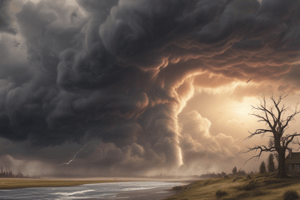Podcast
Questions and Answers
What are some consequences of flooding mentioned in the text?
What are some consequences of flooding mentioned in the text?
- Covering roads and engulfing vehicles
- Destroying critical infrastructure like bridges
- Creating breeding grounds for disease-carrying insects
- All of the above (correct)
Which of the following is NOT a primary cause of flooding according to the text?
Which of the following is NOT a primary cause of flooding according to the text?
- Heavy Rain
- Thunderstorms (correct)
- Ice Jams
- Rapid Snow Melt
What is flash flooding and when does it usually occur?
What is flash flooding and when does it usually occur?
- Flash flooding occurs when rivers overflow their banks due to snowmelt
- Flash flooding occurs during winter due to ice jams
- Flash flooding happens when waters pool into low-lying areas, especially during sustained periods of rainfall (correct)
- Flash flooding is caused by hurricanes during the summer
What precaution is essential to avoid the breeding of disease-carrying insects after a flood?
What precaution is essential to avoid the breeding of disease-carrying insects after a flood?
Which weather condition can lead to riverine flooding as mentioned in the text?
Which weather condition can lead to riverine flooding as mentioned in the text?
What impact can ice jams have on river systems according to the text?
What impact can ice jams have on river systems according to the text?
What is a known contributor to increased flooding risk?
What is a known contributor to increased flooding risk?
Which type of tornado forms over land instead of near a thunderstorm cloud base?
Which type of tornado forms over land instead of near a thunderstorm cloud base?
What is an ideal environment for the development of powerful tornadoes?
What is an ideal environment for the development of powerful tornadoes?
Which type of tornado features multiple visible funnel clouds rotating around a common center?
Which type of tornado features multiple visible funnel clouds rotating around a common center?
What type of tornado is formed over open bodies of water and becomes more dangerous upon encountering shorelines?
What type of tornado is formed over open bodies of water and becomes more dangerous upon encountering shorelines?
What process fuels possible future tornado development by causing instability when warm air meets cooler, denser air masses?
What process fuels possible future tornado development by causing instability when warm air meets cooler, denser air masses?
Study Notes
Tornadoes and Flooding: A Comprehensive Look
Every year, communities across North America face the dual threat of tornadoes and floods, which can have devastating consequences when they occur together. Let's explore their connections, impacts, and essential precautions.
Effects of Flooding
When rivers overflow their banks due to heavy rainfall, rapid snowmelt, ice jams, or other factors, flooding occurs, often causing widespread damage. This excess water can cover roads, engulf vehicles, inundate homes, destroy critical infrastructure like bridges, and leave urban areas isolated. Moreover, stagnant floodwater creates breeding grounds for disease-carrying insects, making it crucial to drain floodwaters promptly and effectively.
Causes of Flooding
Floods result from several primary causes:
- Heavy Rain: Excessive precipitation overwhelms local streams and rivers, leading to riverine flooding. When these waters pool into low-lying areas – especially during sustained periods of rainfall - flash flooding may ensue.
- Rapid Snow Melt: As temperatures rise before winter has fully ended, melting snows increase streamflow, potentially overwhelming rivers and surrounding lands.
- Ice Jams: Ice dams build up along frozen rivers during cold spells, only to melt suddenly, releasing pent-up water with tremendous force.
- Deforestation & Development: Alterations to natural landscapes through deforestation or construction are known contributors to increased flooding risk by reducing surface absorption capacity and accelerated runoff.
Tornado Safety Measures
Tornadoes often coincide with severe storm systems that cause flooding, posing additional risks. To remain safe during such events, consider taking the following steps:
- Stay Informed: Monitor weather forecasts closely, particularly those detailing storm severity and location.
- Find Safe Spaces: Identify solid structures within your community that serve as shelters, ideally basements or interior rooms without windows on all sides.
- Seek Higher Ground: For areas prone to both tornadic activity and potential flooding, find shelter on higher ground.
- Avoid Waterways: Stay away from creeks, rivers, ponds, lakes, or any other bodies of water where tornado debris could accumulate rapidly.
- Protect Yourself: If outdoors, seek shelter beneath thick coverings, lie flat, protect your head, and prevent injury from flying objects.
Types of Tornadoes
Understanding various tornado types is vital for predicting behavior patterns and devising appropriate responses:
- Landspout Tornados: These weak tornadoes form over land instead of near a thunderstorm cloud base. They usually pose minimal threats because they do not touch the ground continuously.
- Water Spout Tornados: Formed over open bodies of water, water spouts feature similar attributes to landspout tornadoes. However, they become more dangerous once encountering shorelines.
- Multi-vortex Tornadoes: Also referred to as multiple vortex tornadoes, this type features two or more visible funnel clouds rotating simultaneously around a common center. Their larger size and complexity present heightened dangers compared to single-funnel variants.
Formation of Tornadoes
To better understand why tornadoes may accompany flooding conditions, we must first grasp their complex formation process:
- Cold Front Collision: When warm air meets cooler, denser air masses as frontal boundaries collide, instability ensues, fueling possible future tornado development.
- Rotational Wind Patterns: Air within the atmosphere flows in opposing directions, creating vertical winds called mesocyclones and supercells – ideal environments for powerful tornadoes.
- Updrafts and Downdrafts: Convection cells generate ascending currents termed updrafts capable of lifting moisture high into the troposphere. Oppositely directed downdrafts may pull condensation back downward, contributing to the formation of funnels.
In conclusion, understanding how flooding impacts tornadoes and vice versa helps improve our preparedness efforts while providing insights into their interconnected nature. By remaining informed, actively seeking protection, and becoming familiarized with local environmental conditions, you will enhance your ability to respond appropriately when facing these challenging circumstances.
Studying That Suits You
Use AI to generate personalized quizzes and flashcards to suit your learning preferences.
Description
Explore the connections between tornadoes and floods, their impacts, safety measures, tornado types, and formation processes. Enhance your understanding of these natural disasters and how to stay safe in the face of such challenges.





